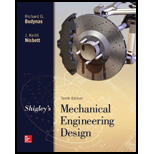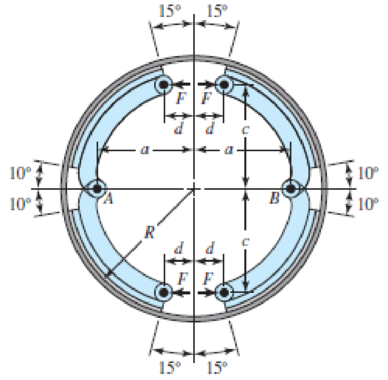
Concept explainers
The figure shows a 400-mm-diameter brake drum with four internally expanding shoes. Each of the hinge pins A and B supports a pair of shoes. The actuating

Problem 16–4
The dimensions in millimeters are a = 150, c = 165, R = 200, and d = 50.
(a) Determine the maximum actuating force.
(b) Estimate the brake capacity.
(c) Noting that rotation may be in either direction, estimate the hinge-pin reactions.
(a)
The maximum actuating force.
Answer to Problem 4P
The maximum actuating force is
Explanation of Solution
Write the expression for moment of frictional forces.
Here, coefficient of friction is
Write the expression for moment of normal forces.
Here, moment of normal forces is
Write the expression for actuating force.
Here, actuating force is
Conclusion:
Calculate
Substitute
Substitute
Substitute
Thus, the maximum actuating force is
(b)
The total braking capacity.
Answer to Problem 4P
The total braking capacity is
Explanation of Solution
Write the expression for torque applied by primary shoe.
Here, braking torque applied by primary shoe is
Write the expression for moment of frictional forces.
Here, moment of frictional forces for secondary shoe is
Write the expression for normal forces for secondary shoes.
Here, normal forces for secondary shoes is
Write the expression for actuating forces.
Here actuating force is
Write the expression\n for braking torque on left hand side shoe.
Write the expression for total braking torque.
Here, total braking torque is
Conclusion:
Substitute
Substitute
Substitute
Substitute
Substitute
Substitute
Thus, the total braking capacity is
(c)
The horizontal reaction on primary shoes.
The vertical reaction on primary shoe.
The horizontal reaction on secondary shoes.
The vertical reaction on secondary shoe.
The resultant reaction.
Answer to Problem 4P
The horizontal reaction on primary shoes is
The, the vertical reaction on primary shoe is
The horizontal reaction on secondary shoes is
The, the vertical reaction on secondary shoe is
The resultant reaction is
Explanation of Solution
Write the expression for horizontal reaction on hinge pin for primary shoe.
Here, horizontal reaction is
Write the expression for vertical reaction on hinge pin for primary shoe.
Here, vertical reaction is
Write the expression for horizontal reaction on hinge pin for secondary shoe.
Here, horizontal reaction on hinge pin for secondary shoe is
Write the expression for vertical reaction on hinge pin for secondary shoe.
Here, vertical reaction on hinge pin for secondary shoe is
Write the expression for net horizontal reaction.
Here, net horizontal reaction is
Write the expression for net vertical reaction.
Here, net vertical reaction is
Here, resultant reaction is
Conclusion
Substitute
Thus horizontal reaction on primary shoes is
Substitute
Thus, the vertical reaction on primary shoe is
Substitute
Thus horizontal reaction on secondary shoes is
Substitute
Thus, the vertical reaction on secondary shoe is
Substitute
Substitute
Substitute
Thus, the resultant reaction is
Want to see more full solutions like this?
Chapter 16 Solutions
Shigley's Mechanical Engineering Design (McGraw-Hill Series in Mechanical Engineering)
- The width of the simple band brake shown in the figure is 30 mm. The coefficient of friction between the brake and the drum surface is 0.20. Determine the braking torque and thickness of the band if the tensile stress is not to exceed 65 N/mm2.arrow_forwardThe figure shows an internal rim-type brake having an inside rim diameter of 11in and a dimension R of 3.5 in. The shoes have a face width of 1.25 in. Find the braking torque and the maximum pressure for each shoe if the actuating force is 205 Ibf, the drum rotation is counterclockwise, and f=0.32. The maximum pressure on the right-hand shoe parp is [ 16.99] @ psi. The maximum pressure on the left-hand shoe pa| H is [100.813 | @ psi. The torque on the right-hand shoe Tgis [ .056 | @ kipin. The torque on the left-hand shoe T is [ .332| @ kipin. Total braking torque Tiotal s [-3887] @ Kip-in.arrow_forward8. Design a clamp coupling for transmitting 25 kW at 300 rpm. Allowable shear stresses in shaft and key are 50 MPa and 45 MPa, respectively. The number of bolts joining the two halves of muff is 4. The permissible tensile stress in the bolt is 70 MPa and the permissible crushing stress in the key is 90 MPa. The coeffi cient of friction between the muff of the CI and the shaft of steel is 0.20.arrow_forward
- For the same question, the Impeller hub will be pressed onto the taper shaft with the Nut. How much FORCE should the nut create for this? Also, if the nut loosens and falls off, calculate whether the connection will be DISCONNECTED by itself. (Do not take the values from the previous question, use the values given in this question!) Engine power P=27 kW, RPM n=1684 rpm, Connection MEDIUM vibrating, Conical inclination angle α=1, Coefficient of Friction μ=0.3 , Average of the conical part diameter d=24 mm, connection width b=96 mmarrow_forwardIn a particular application, the radial load acting on a ball bearing is 5 kN and the expected life for 90% of the hearings is 8000 Calculate the dynamic load carrying capacity of the bearing, when the shaft rotates at 1450 rpm.arrow_forward1. A double square thread power screw has a pitch of 6 mm and mean radius of34 mm. If it is used to lift a load 50 kN and coefficient of friction of threads is 0.15, determine the torque required toturn the screw.A. 343.74 N-m B. 353.47 N-m C. 335.47 N-m D. 347.35 N-m2. A lubricated bolt needs an initial torque of 145 lb-ft to take the initial tension brought by the compressor withoutbreaking. Determine the initial torque needed by the bolt if the bolt was not lubricated.A. 107.85 lb-ft B.108.25 lb-ft C. 108.75 lb-ft D. 193.33 lb-ftarrow_forward
- A differential band brake is shown in the figure. The diameter of the drum is 800 mm. The coefficient of friction between the band and the drum is 0.3 and the angle of embrace is 240°. When a force of 777 N is applied at the free end of the lever, find: a. The maximum force, in Newtons, in the band for the clockwise rotation of the drum b. The minimum force, in Newtons, in the band for the clockwise rotation of the drum c. The maximum force, in Newtons, in the band for the counter clockwise rotation of the drum d. The minimum force, in Newtons, in the band for the counter clockwise rotation of the drum e. The torque which can be applied by the brake, in N-m, for the clockwise rotation of the drum.arrow_forwardThe worm shaft shown in the figure transmits 1-kW at 500 rev/min. A static forceanalysis results are also shown in the figure. Bearing A is to be an angular-contact ballbearing mounted to take the 2.75 kN thrust load. The bearing at B is to take only theradial load, so a straight roller bearing will be employed. Use an application factor of1.2, a desired life of 25 kh, and a combined reliability goal of 0.99. (a)Specify each bearing by giving all required charecteristics. (b) Determine the radial and thrust components of loads on each bearing. (c) Make a design assessment for each bearing and of the system.arrow_forwardA vertical power screw with double start square threads of 50 mm mean diameter and 11mm pitch is raised against a load of 10 kN by means of a hand wheel, the boss of which is threaded to act as a nut. A thrust collar, taking up the axial load,supports the wheel boss and has a mean diameter of 60mm. The coefficient of friction is 0.18for the screw and 0.16for the collar. If the tangential force applied by each hand to the wheel is 200 N, find suitable diameter of the hand wheel.arrow_forward
- Two pulleys, one 650 mm diameter and the other 400 mm diameter, on parallel shafts 1.5 m apart are connected by a flat belt. Find the length of the belt required and the angle of contact between the belt and each pulley. What power can be transmitted by the belt when the larger pulley rotates at 1200 rev/min, if the maximum permissible tension in the belt is 10 kN, and the coefficient of friction between the belt and pulley is 0.05? give proper explaination and dont give handwritten solution.arrow_forward(2) A single square thread jackscrew has 2.0TPI. It is to lift 15 tons. The friction radius of the collar is 1-in. The coefficient of friction between the threads and screws and base is 0.15, that between the screw and collar is 0.13. Determine: (a) the diameter of the root of the screw if the allowable stress in compression is 6,000psi; (b) the pull required at the end of 5.0ft bar to raise the load; (c) the twisting moment exerted at the root of the threads; (d) the efficiency of the screw and collar.arrow_forwardA cylinder with a nominal 2.5 in ID, a 4.0 in OD, and a 3.0 in length is to be mated with a solid shaft with a nominal 2.5 in diameter. A medium drive fit is desired (as defined in Table 7-9). The cylinder and shaft are made from steel, with Sy = 100 kpsi and E = 30 Mpsi. The coefficient of friction for the steel interface is 0.7. a. Specify the maximum and minimum allowable diameters for both the cylinder hole and the shaft. b. Determine the torque that can be transmitted through this joint, assuming the shaft and cylinder are both manufactured within their tolerances such that the minimum interference is achieved. c. Suppose the shaft and cylinder are both manufactured within their tolerances such that the maximum interference is achieved. Check for yielding of the cylinder at its inner radius by finding the following: i. The pressure at the interface ii. The tangential and radial stresses in the cylinder, at its inner radius. iii. The factor of safety for static yielding of the…arrow_forward
 Mechanics of Materials (MindTap Course List)Mechanical EngineeringISBN:9781337093347Author:Barry J. Goodno, James M. GerePublisher:Cengage Learning
Mechanics of Materials (MindTap Course List)Mechanical EngineeringISBN:9781337093347Author:Barry J. Goodno, James M. GerePublisher:Cengage Learning
